Digital Platforms for the Built Environment: A Systematic Review Across Sectors and Scales
Abstract
1. Introduction
2. Methodology
3. Thematic Domains Analysis
3.1. Artificial Intelligence in Digital Platforms
3.1.1. AI-Integrated Digital Platforms for Improved Construction Safety and Efficiency
3.1.2. Improved Sustainability and Resource Efficiency Through AI
3.1.3. AI-Integrated Platforms for Smart Urbanism, Collaboration and Innovation
3.2. Digital Twin Integration Through Digital Platforms
3.2.1. Monitoring of Structures and Infrastructures
3.2.2. Smart City
3.2.3. Cultural Heritage
3.2.4. Energy Efficiency
3.3. Digital Platforms for Lifecycle Cost Management
3.3.1. Data Integration Across Domains
3.3.2. Transparency and Traceability
3.3.3. Data Driven Process Optimization Through Automation
3.4. BIM-GIS Integration Platforms for Underground Utility Infrastructure
3.4.1. Digital Platforms with Focus on Planning Stage
3.4.2. Digital Platforms with Focus on Operation and Maintenance Stage
3.4.3. Digital Platforms with Multi-Stage Lifecycle Focus
3.5. Digital Platforms in the Energy Sector
3.5.1. Digital Platforms for Energy Communities
3.5.2. Digital Platforms Based on Advanced Technologies
3.5.3. Social Implications of Digital Platforms
3.6. Digital Platforms in Public Administration and Governance
3.6.1. Participatory Platforms
3.6.2. E-Government Platforms and Open Data
4. Discussion (Cross-Domain Synthesis)
5. Conclusions
- Issues related to data, including fragmentation, inconsistency, lack of interoperability and privacy/security risks;
- Usability barriers, caused by limited digital skills and a lack of user engagement;
- Process fragmentation, causing inefficiencies and decision-making bottlenecks;
- Sustainability and governance issues, in terms of high deployment cost, socio-economic disparity and inadequate platform governance models.
- Use of modular, microservice and service-oriented architectures for scalable, interoperable and flexible platforms;
- Development of multi-scale, multi-domain and standardized ontologies in order to harmonize and make data accessible and reusable;
- Merging explainable and probabilistic AI models that guarantee transparent, trustworthy and human-in-the-loop decision-making, particularly in uncertain and complex contexts;
- Redesigning workflows and processes into participative, process-based and data-centered digital environments;
- Establishment of transparent, participatory, and cooperative platform governance models aimed at fostering user empowerment and inclusiveness.
Supplementary Materials
Author Contributions
Funding
Data Availability Statement
Acknowledgments
Conflicts of Interest
References
- Rafsanjani, H.N.; Nabizadeh, A.H. Towards Digital Architecture, Engineering, and Construction (AEC) Industry through Virtual Design and Construction (VDC) and Digital Twin. Energy Built Environ. 2023, 4, 169–178. [Google Scholar] [CrossRef]
- Panteli, C.; Kylili, A.; Fokaides, P.A. Building Information Modelling Applications in Smart Buildings: From Design to Commissioning and beyond A Critical Review. J. Clean. Prod. 2020, 265, 121766. [Google Scholar] [CrossRef]
- Osorio-Gómez, C.C.; Herrera, R.F.; Prieto-Osorio, J.M.; Pellicer, E. Conceptual Model for Implementation of Digital Transformation and Organizational Structure in the Construction Sector. Ain Shams Eng. J. 2024, 15, 102749. [Google Scholar] [CrossRef]
- Brozovsky, J.; Labonnote, N.; Vigren, O. Digital technologies in architecture, engineering, and construction. J. Autom. Constr. 2024, 158, 105212. [Google Scholar] [CrossRef]
- Horry, R.; Booth, C.A.; Mahamadu, A.; Manu, P.; Georgakis, P. Environmental Management Systems in the Architectural, Engineering and Construction Sectors: A Roadmap to Aid the Delivery of the Sustainable Development Goals. Environ. Dev. Sustain. 2022, 24, 10585–10615. [Google Scholar] [CrossRef]
- Zhang, Z.; Wei, Z.; Court, S.; Yang, L.; Wang, S.; Thirunavukarasu, A.; Zhao, Y. A Review of Digital Twin Technologies for Enhanced Sustainability in the Construction Industry. Buildings 2024, 14, 1113. [Google Scholar] [CrossRef]
- Asif, M.; Naeem, G.; Khalid, M. Digitalization for Sustainable Buildings: Technologies, Applications, Potential, and Challenges. J. Clean. Prod. 2024, 450, 141814. [Google Scholar] [CrossRef]
- Teclaw, W.; O’Donnel, J.; Kukkonen, V.; Pauwels, P.; Labonnote, N.; Hjelseth, E. Federating Cross-Domain BIM-Based Knowledge Graph. Adv. Eng. Inform. 2024, 62, 102770. [Google Scholar] [CrossRef]
- Lee, D.; Lee, S.H.; Masoud, N.; Krishnan, M.S.; Li, V.C. Integrated Digital Twin and Blockchain Framework to Support Accountable Information Sharing in Construction Projects. Autom. Constr. 2021, 127, 103688. [Google Scholar] [CrossRef]
- Salzano, A.; Cascone, S.; Zitiello, E.P.; Nicolella, M. HVAC System Performance in Educational Facilities: A Case Study on the Integration of Digital Twin Technology and IoT Sensors for Predictive Maintenance. J. Archit. Eng. 2025, 31, 04025004. [Google Scholar] [CrossRef]
- Brandín, R.; Abrishami, S. Information Traceability Platforms for Asset Data Lifecycle: Blockchain-Based Technologies. Smart Sustain. Built Environ. 2021, 10, 364–386. [Google Scholar] [CrossRef]
- Chen, X.; Chang-Richards, A.Y.; Ling, F.Y.Y.; Yiu, T.W.; Pelosi, A.; Yang, N. Digital Technology-Enabled AEC Project Management: Practical Use Cases, Deployment Patterns and Emerging Trends. Eng. Constr. Archit. Manag. 2024, 32, 4125–4154. [Google Scholar] [CrossRef]
- Bosch-Sijtsema, P.; Claeson-Jonsson, C.; Johansson, M.; Roupe, M. The Hype Factor of Digital Technologies in AEC. Constr. Innov. 2021, 21, 899–916. [Google Scholar] [CrossRef]
- Turk, Ž. Structured Analysis of ICT Adoption in the European Construction Industry. Int. J. Constr. Manag. 2023, 23, 756–762. [Google Scholar] [CrossRef]
- Naji, K.K.; Gunduz, M.; Alhenzab, F.; Al-Hababi, H.; Al-Qahtani, A. Assessing the Digital Transformation Readiness of the Construction Industry Utilizing the Delphi Method. Buildings 2024, 14, 601. [Google Scholar] [CrossRef]
- Serrano, W. Digital Systems in Smart City and Infrastructure: Digital as a Service. Smart Cities 2018, 1, 134–154. [Google Scholar] [CrossRef]
- Ang, K.L.-M.; Seng, J.K.P. Application Specific Internet of Things (ASIoTs): Taxonomy, Applications, Use Case and Future Directions. IEEE Access 2019, 7, 56577–56590. [Google Scholar] [CrossRef]
- Rabbi, A.B.K.; Jeelani, I. AI Integration in Construction Safety: Current State, Challenges, and Future Opportunities in Text, Vision, and Audio Based Applications. Autom. Constr. 2024, 164, 105443. [Google Scholar] [CrossRef]
- Page, M.J.; McKenzie, J.E.; Bossuyt, P.M.; Boutron, I.; Hoffmann, T.C.; Mulrow, C.D.; Shamseer, L.; Tetzlaff, J.M.; Akl, E.A.; Brennan, S.E.; et al. The PRISMA 2020 Statement: An Updated Guideline for Reporting Systematic Reviews. BMJ 2021, 372, n71. [Google Scholar] [CrossRef]
- Jiang, X.; Jiang, X.; Sun, W.; Fan, W. How Do Manufacturing Firms Manage Artificial Intelligence to Drive Iterative Product Innovation? IEEE Trans. Eng. Manag. 2024, 71, 6090–6102. [Google Scholar] [CrossRef]
- Bibri, S.E. The Metaverse as a Virtual Model of Platform Urbanism: Its Converging AIoT, XReality, Neurotech, and Nanobiotech and Their Applications, Challenges, and Risks. Smart Cities 2023, 6, 1345–1384. [Google Scholar] [CrossRef]
- Çetin, S.; De Wolf, C.; Bocken, N. Circular Digital Built Environment: An Emerging Framework. Sustainability 2021, 13, 6348. [Google Scholar] [CrossRef]
- Talla, A.; McIlwaine, S. Industry 4.0 and the Circular Economy: Using Design-Stage Digital Technology to Reduce Construction Waste. Smart Sustain. Built Environ. 2024, 13, 179–198. [Google Scholar] [CrossRef]
- Scime, L.; Singh, A.; Paquit, V. A Scalable Digital Platform for the Use of Digital Twins in Additive Manufacturing. Manuf. Lett. 2022, 31, 28–32. [Google Scholar] [CrossRef]
- Fang, W.; Ding, L.; Love, P.E.D.; Luo, H.; Li, H.; Peña-Mora, F.; Zhong, B.; Zhou, C. Computer Vision Applications in Construction Safety Assurance. Autom. Constr. 2020, 110, 103013. [Google Scholar] [CrossRef]
- Homaei, M.; Mogollón-Gutiérrez, Ó.; Sancho, J.C.; Ávila, M.; Caro, A. A Review of Digital Twins and Their Application in Cybersecurity Based on Artificial Intelligence. Artif. Intell. Rev. 2024, 57, 201. [Google Scholar] [CrossRef]
- Ieva, S.; Bilenchi, I.; Gramegna, F.; Pinto, A.; Scioscia, F.; Ruta, M.; Loseto, G. Enhancing Last-Mile Logistics: AI-Driven Fleet Optimization, Mixed Reality, and Large Language Model Assistants for Warehouse Operations. Sensors 2025, 25, 2696. [Google Scholar] [CrossRef]
- Korkas, C.; Dimara, A.; Michailidis, I.; Krinidis, S.; Marin-Perez, R.; García, A.I.M.; Skarmeta, A.; Kitsikoudis, K.; Kosmatopoulos, E.; Anagnostopoulos, C.N.; et al. Integration and Verification of PLUG-N-HARVEST ICT Platform for Intelligent Management of Buildings. Energies 2022, 15, 2610. [Google Scholar] [CrossRef]
- Chashyn, D.; Khurudzhi, Y.; Daukšys, M. Directions for the Formation of «City Intelligent Models» Using Artificial Intelligence for the Post-War Reconstruction of Historical Buildings. Bud. Archit. 2024, 23, 73–86. [Google Scholar] [CrossRef]
- Demura, M. Challenges in Materials Integration. ISIJ Int. 2024, 64, 503–512. [Google Scholar] [CrossRef]
- Mouratiadou, I.; Lemke, N.; Chen, C.; Wartenberg, A.; Bloch, R.; Donat, M.; Gaiser, T.; Basavegowda, D.H.; Helming, K.; Hosseini Yekani, S.A.; et al. The Digital Agricultural Knowledge and Information System (DAKIS): Employing Digitalisation to Encourage Diversified and Multifunctional Agricultural Systems. Environ. Sci. Ecotechnology 2023, 16, 100274. [Google Scholar] [CrossRef]
- Tuzun, U. Artificial Intelligence Assisted Dynamic Control of Environmental Emissions From Hybrid Energy Process Plants (HEPP). Front. Energy Res. 2020, 8, 179. [Google Scholar] [CrossRef]
- Pastor-Escuredo, D.; Treleaven, P.; Vinuesa, R. An Ethical Framework for Artificial Intelligence and Sustainable Cities. AI 2022, 3, 961–974. [Google Scholar] [CrossRef]
- Naseri, F.; Gil, S.; Barbu, C.; Cetkin, E.; Yarimca, G.; Jensen, A.C.; Larsen, P.G.; Gomes, C. Digital Twin of Electric Vehicle Battery Systems: Comprehensive Review of the Use Cases, Requirements, and Platforms. Renew. Sustain. Energy Rev. 2023, 179, 113280. [Google Scholar] [CrossRef]
- Peng, X.; Li, Y.; Si, Y.; Xu, L.; Liu, X.; Li, D.; Liu, Y. A Social Sensing Approach for Everyday Urban Problem-Handling with the 12345-Complaint Hotline Data. Comput. Env. Urban Syst. 2022, 94, 101790. [Google Scholar] [CrossRef]
- He, W. Urban Experiment: Taking Off on the Wind of Al. Archit. Des. 2020, 90, 94–99. [Google Scholar] [CrossRef]
- Huang, Y.; Yang, S. Machine Learning Model for Building Type Classification of Cultural Heritage Sites along Jiangnan Canal: A Comparative Study of Historical and Modern Images. Int. J. Des. Soc. 2024, 18, 77–96. [Google Scholar] [CrossRef]
- Liyanage, S.; Dia, H.; Abduljabbar, R.; Bagloee, S.A. Flexible Mobility On-Demand: An Environmental Scan. Sustainability 2019, 11, 1262. [Google Scholar] [CrossRef]
- Beiró, M.G.; Panisson, A.; Tizzoni, M.; Cattuto, C. Predicting Human Mobility through the Assimilation of Social Media Traces into Mobility Models. EPJ Data Sci. 2016, 5, 30. [Google Scholar] [CrossRef]
- Bernasconi, C.; Blume, L.B. Theorizing Architectural Research and Practice in the Metaverse: The Meta-Context of Virtual Community Engagement. Int. J. Archit. Res. Archnet-IJAR 2023, 19, 108–127. [Google Scholar] [CrossRef]
- IDTA—Der Standard Für Den Digitalen Zwilling—Startseite. Available online: https://industrialdigitaltwin.org/ (accessed on 29 April 2025).
- Volz, F.; Sutschet, G.; Stojanovic, L.; Usländer, T. On the Role of Digital Twins in Data Spaces. Sensors 2023, 23, 7601. [Google Scholar] [CrossRef]
- Cavalieri, S.; Gambadoro, S. Proposal of Mapping Digital Twins Definition Language to Open Platform Communications Unified Architecture. Sensors 2023, 23, 2349. [Google Scholar] [CrossRef]
- Sun, H.; Liu, Z. Research on Intelligent Dispatching System Management Platform for Construction Projects Based on Digital Twin and BIM Technology. Adv. Civ. Eng. 2022, 2022, 1–19. [Google Scholar] [CrossRef]
- Cakir, L.V.; Ozdem, M.; Ahmadi, H.; Canberk, B.; Duong, T.Q. Internet of Twins (IoTw) Approach: Digital Twin as a Platform (DTaaP) Architecture. IEEE Internet Comput. 2024, 29, 65–74. [Google Scholar] [CrossRef]
- Chacón, R.; Casas, J.R.; Ramonell, C.; Posada, H.; Stipanovic, I.; Škarić, S. Requirements and Challenges for Infusion of SHM Systems within Digital Twin Platforms. Struct. Infrastruct. Eng. 2023, 21, 599–615. [Google Scholar] [CrossRef]
- Rodríguez-Alonso, C.; Pena-Regueiro, I.; García, Ó. Digital Twin Platform for Water Treatment Plants Using Microservices Architecture. Sensors 2024, 24, 1568. [Google Scholar] [CrossRef]
- Fawad, M.; Salamak, M.; Chen, Q.; Uscilowski, M.; Koris, K.; Jasinski, M.; Lazinski, P.; Piotrowski, D. Development of Immersive Bridge Digital Twin Platform to Facilitate Bridge Damage Assessment and Asset Model Updates. Comput. Ind. 2025, 164, 104189. [Google Scholar] [CrossRef]
- Keskin, B.; Salman, B.; Koseoglu, O. Architecting a BIM-Based Digital Twin Platform for Airport Asset Management: A Model-Based System Engineering with SysML Approach. J. Constr. Eng. Manag. 2022, 148, 04022020. [Google Scholar] [CrossRef]
- Li, H.; Zhang, R.; Zheng, S.; Shen, Y.; Fu, C.; Zhao, H. Digital Twin-Driven Intelligent Operation and Maintenance Platform for Large-Scale Hydro-Steel Structures. Adv. Eng. Inform. 2024, 62, 102661. [Google Scholar] [CrossRef]
- Zhou, C.; Qin, W.; Luo, H.; Yu, Q.; Fan, B.; Zheng, Q. Digital Twin for Smart Metro Service Platform: Evaluating Long-Term Tunnel Structural Performance. Autom. Constr. 2024, 167, 105713. [Google Scholar] [CrossRef]
- Dani, A.A.H.; Supangkat, S.H.; Lubis, F.F.; Nugraha, I.G.B.B.; Kinanda, R.; Rizkia, I. Development of a Smart City Platform Based on Digital Twin Technology for Monitoring and Supporting Decision-Making. Sustainability 2023, 15, 14002. [Google Scholar] [CrossRef]
- Cho, Y.; Kim, S.; Lee, J.; Ko, D.; Lee, H.; Baek, Y.; Lee, M. Low-Cost Urban Heat Environment Sensing Device with Android Platform for Digital Twin. HardwareX 2024, 20, e00598. [Google Scholar] [CrossRef] [PubMed]
- Lee, A.; Lee, K.W.; Kim, K.H.; Shin, S.W. A Geospatial Platform to Manage Large-Scale Individual Mobility for an Urban Digital Twin Platform. Remote Sens. 2022, 14, 723. [Google Scholar] [CrossRef]
- Yang, S.; Kim, H. Urban Digital Twin Applications as a Virtual Platform of Smart City. Int. J. Sustain. Build. Technol. Urban Dev. 2021, 12, 363–379. [Google Scholar] [CrossRef]
- Niccolucci, F.; Felicetti, A.; Hermon, S. Populating the Data Space for Cultural Heritage with Heritage Digital Twins. Data 2022, 7, 105. [Google Scholar] [CrossRef]
- Turilazzi, B.; Leoni, G.; Gaspari, J.; Masari, M.; Boulanger, S.O.M. Cultural Heritage and Digital Tools: The Rock Interoperable Platform. Int. J. Environ. Impacts 2021, 4, 276–288. [Google Scholar] [CrossRef]
- Li, C.; Lu, P.; Zhu, W.; Zhu, H.; Zhang, X. Intelligent Monitoring Platform and Application for Building Energy Using Information Based on Digital Twin. Energies 2023, 16, 6839. [Google Scholar] [CrossRef]
- Han, F.; Du, F.; Jiao, S.; Zou, K. Predictive Analysis of a Building’s Power Consumption Based on Digital Twin Platforms. Energies 2024, 17, 3692. [Google Scholar] [CrossRef]
- Kolahi, M.; Esmailifar, S.M.; Moradi Sizkouhi, A.M.; Aghaei, M. Digital-PV: A Digital Twin-Based Platform for Autonomous Aerial Monitoring of Large-Scale Photovoltaic Power Plants. Energy Convers. Manag. 2024, 321, 118963. [Google Scholar] [CrossRef]
- Banfi, F.; Brumana, R.; Salvalai, G.; Previtali, M. Digital Twin and Cloud BIM-XR Platform Development: From Scan-to-BIM-to-DT Process to a 4D Multi-User Live App to Improve Building Comfort, Efficiency and Costs. Energies 2022, 15, 4497. [Google Scholar] [CrossRef]
- Qian, Y.; Leng, J.; Zhou, K.; Liu, Y. How to Measure and Control Indoor Air Quality Based on Intelligent Digital Twin Platforms: A Case Study in China. Build. Environ. 2024, 253, 111349. [Google Scholar] [CrossRef]
- Goh, B.H.; Sun, Y. The Development of Life-Cycle Costing for Buildings. Build. Res. Inf. 2016, 44, 319–333. [Google Scholar] [CrossRef]
- Choi, J.; Kim, H.; Kim, I. Open BIM-Based Quantity Take-off System for Schematic Estimation of Building Frame in Early Design Stage. J. Comput. Des. Eng. 2015, 2, 16–25. [Google Scholar] [CrossRef]
- Zhang, Z.; Liu, H.; Xu, J.; Shu, Y.; Liu, H.; Xiao, J. Ontology-Based Integrated Cost Management System for Real Estate Development. In ICCREM 2022: Carbon Peak and Neutrality Strategies of the Construction Industry; American Society of Civil Engineers: Reston, VA, USA, 2022; Volume 2022, pp. 838–854. [Google Scholar] [CrossRef]
- Li, C.Z.; Xue, F.; Li, X.; Hong, J.; Shen, G.Q. An Internet of Things-Enabled BIM Platform for on-Site Assembly Services in Prefabricated Construction. Autom. Constr. 2018, 89, 146–161. [Google Scholar] [CrossRef]
- Wang, Y.; Lu, H.; Wang, Y.; Yang, Z.; Wang, Q.; Zhang, H. A Hybrid Building Information Modeling and Collaboration Platform for Automation System in Smart Construction. Alex. Eng. J. 2024, 88, 80–90. [Google Scholar] [CrossRef]
- Hagedorn, P.; Pauwels, P.; König, M. Semantic Rule Checking of Cross-Domain Building Data in Information Containers for Linked Document Delivery Using the Shapes Constraint Language. Autom. Constr. 2023, 156, 105106. [Google Scholar] [CrossRef]
- Yilmaz, S.; Kumar, D.; Hada, S.; Demirkesen, S.; Zhang, C.; Li, H. A PMBOK-Based Construction Cost Management Framework for BIM Integration in Construction Projects. Int. J. Constr. Manag. 2025, 25, 861–875. [Google Scholar] [CrossRef]
- Hagedorn, P.; Liu, L.; König, M.; Hajdin, R.; Blumenfeld, T.; Stöckner, M.; Billmaier, M.; Grossauer, K.; Gavin, K. BIM-Enabled Infrastructure Asset Management Using Information Containers and Semantic Web. J. Comput. Civ. Eng. 2023, 37, 04022041. [Google Scholar] [CrossRef]
- Katipamula, S.; Gowri, K.; Hernandez, G. An Open-Source Automated Continuous Condition-Based Maintenance Platform for Commercial Buildings. Sci. Technol. Built Environ. 2017, 23, 546–556. [Google Scholar] [CrossRef]
- Li, X.; Lu, W.; Xue, F.; Wu, L.; Zhao, R.; Lou, J.; Xu, J. Blockchain-Enabled IoT-BIM Platform for Supply Chain Management in Modular Construction. J. Constr. Eng. Manag. 2021, 148, 04021195. [Google Scholar] [CrossRef]
- Stas, S.; Abrishami, S. Decentralised Automated BIM Collaboration: A Blockchain and WBS Integrated Platform. Smart Sustain. Built Environ. 2024; ahead of print. [Google Scholar] [CrossRef]
- Yu, Z.; Sun, J. Green Cooperation Strategy of Prefabricated Building Supply Chain Based on Smart Construction Management Platform. Sustainability 2023, 15, 15882. [Google Scholar] [CrossRef]
- Yang, J.; Zhong, B. Fairness Model Considering Satisfaction and Preferences for Service Scheduling on Electronic Platforms in Construction Industry. Expert. Syst. Appl. 2024, 244, 122872. [Google Scholar] [CrossRef]
- Hu, H.; Huang, T.; Cheng, Y.; Lu, H. The Evolution of Sustainable Business Model Innovation: Evidence from a Sharing Economy Platform in China. Sustainability 2019, 11, 4207. [Google Scholar] [CrossRef]
- Wu, Z. Application of Artificial Intelligence Technology in Smart Building Integrated Management Platform under Big Data Environment. Appl. Math. Nonlinear Sci. 2024, 9. [Google Scholar] [CrossRef]
- Icoglu, O.; Brunner, K.A.; Mahdavi, A.; Suter, G. A Distributed Location Sensing Platform for Dynamic Building Models. In Ambient Intelligence. Proceedings of the European Symposium on Ambient Intelligence (EUSAI 2004), Eindhoven, The Netherlands, 8–11 November 2024; Lecture Notes in Computer Science; Springer: Berlin/Heidelberg, Germany, 2004; Volume 3295, pp. 124–135. [Google Scholar] [CrossRef]
- Mishchenko, V.; Lapidus, A.; Topchiy, D.; Kazakov, D. Organizational and Technological Platform for Monolithic Construction Using Pneumatic Formwork. Civ. Eng. J. 2023, 9, 2787–2795. [Google Scholar] [CrossRef]
- Wu, N.; Shih, S.G. A BIM Inspired Supporting Platform for Architectural Design. Comput. Aided Des. Appl. 2015, 12, 327–337. [Google Scholar] [CrossRef]
- Núñez, D.; Ferrada, X.; Neyem, A.; Serpell, A.; Sepúlveda, M. A User-Centered Mobile Cloud Computing Platform for Improving Knowledge Management in Small-to-Medium Enterprises in the Chilean Construction Industry. Appl. Sci. 2018, 8, 516. [Google Scholar] [CrossRef]
- Gilbert, T.; Barr, S.; James, P.; Morley, J.; Ji, Q. Software Systems Approach to Multi-Scale GIS-BIM Utility Infrastructure Network Integration and Resource Flow Simulation. ISPRS Int. J. Geoinf. 2018, 7, 310. [Google Scholar] [CrossRef]
- Howell, S.; Rezgui, Y.; Beach, T. Integrating Building and Urban Semantics to Empower Smart Water Solutions. Autom. Constr. 2017, 81, 434–448. [Google Scholar] [CrossRef]
- Demir, S.; Yomralioglu, T. Bridging Geo-Data and Natural Gas Pipeline Design Standards: A Systematic Review of BIM-GIS Integration for Natural Gas Pipeline Asset Management. Energies 2024, 17, 2306. [Google Scholar] [CrossRef]
- Azevedo, D.M.; Lamounier, E.; Guttler, C.; Marotti, A.; De Lima, G.F.M.; Rocha, R.D.O.; Cardoso, A.; De Araújo, A.L.; Bartholomeu, C. Development of BIM (Building Information Modeling) Concept Applied to Projects of Substations Integrated with the Geographic Intelligence System. WSEAS Trans. Power Syst. 2021, 16, 1–7. [Google Scholar] [CrossRef]
- Wang, S.; Sun, Y.; Sun, Y.; Guan, Y.; Feng, Z.; Lu, H.; Cai, W.; Long, L. A Hybrid Framework for High-Performance Modeling of Three-Dimensional Pipe Networks. ISPRS Int. J. Geoinf. 2019, 8, 441. [Google Scholar] [CrossRef]
- Zhao, L.; Liu, Z.; Mbachu, J. An Integrated BIM–GIS Method for Planning of Water Distribution System. ISPRS Int. J. Geoinf. 2019, 8, 331. [Google Scholar] [CrossRef]
- Wang, X.; Huo, L.; Shen, T.; Yang, X.; Bai, H. A Web3D Rendering Optimization Algorithm for Pipeline BIM Models. Buildings 2023, 13, 2309. [Google Scholar] [CrossRef]
- Marzouk, M.; Othman, A. Planning Utility Infrastructure Requirements for Smart Cities Using the Integration between BIM and GIS. Sustain. Cities Soc. 2020, 57, 102120. [Google Scholar] [CrossRef]
- Rabia, R.M.P.; Kumar, S.D. BIM and GIS Integrated Utility Supply Station Location Optimization and Possibilities. J. Appl. Eng. Sci. 2022, 20, 184–1394. [Google Scholar] [CrossRef]
- Zhang, S.; Hou, D.; Wang, C.; Pan, F.; Yan, L. Integrating and Managing BIM in 3D Web-Based GIS for Hydraulic and Hydropower Engineering Projects. Autom. Constr. 2020, 112, 103114. [Google Scholar] [CrossRef]
- Lee, P.C.; Wang, Y.; Lo, T.P.; Long, D. An Integrated System Framework of Building Information Modelling and Geographical Information System for Utility Tunnel Maintenance Management. Tunn. Undergr. Space Technol. 2018, 79, 263–273. [Google Scholar] [CrossRef]
- Wang, M.; Deng, Y.; Won, J.; Cheng, J.C.P. An Integrated Underground Utility Management and Decision Support Based on BIM and GIS. Autom. Constr. 2019, 107, 102931. [Google Scholar] [CrossRef]
- Shekargoftar, A.; Taghaddos, H.; Azodi, A.; Nekouvaght Tak, A.; Ghorab, K. An Integrated Framework for Operation and Maintenance of Gas Utility Pipeline Using BIM, GIS, and AR. J. Perform. Constr. Facil. 2022, 36. [Google Scholar] [CrossRef]
- Rajadurai, R.; Vilventhan, A. Integration of Building Information Modeling, Geographic Information System, and Augmented Reality for Visualization and Management of Multiple Underground Utilities. J. Pipeline Syst. Eng. Pr. 2025, 16. [Google Scholar] [CrossRef]
- Lee, J.; Lee, Y.; Hong, C. Development of Geospatial Data Acquisition, Modeling, and Service Technology for Digital Twin Implementation of Underground Utility Tunnel. Appl. Sci. 2023, 13, 4343. [Google Scholar] [CrossRef]
- Lee, J.; Lee, Y.; Park, S.; Hong, C. Implementing a Digital Twin of an Underground Utility Tunnel for Geospatial Feature Extraction Using a Multimodal Image Sensor. Appl. Sci. 2023, 13, 9137. [Google Scholar] [CrossRef]
- Bansal, V.K. Integrated Framework of BIM and GIS Applications to Support Building Lifecycle: A Move toward ND Modeling. J. Archit. Eng. 2021, 27, 05021009. [Google Scholar] [CrossRef]
- Ma, F.; Gao, Y.; Zhang, G.; Huang, C.; Chen, W. An Underground Pipeline Relocation Decision Support System Based on BIM and GIS Integration; Journal of Physics: Conference Series; IOP Publishing Ltd.: Bristol, UK, 2024; Volume 2824. [Google Scholar]
- Huang, Y.; Peng, H.; Wen, L.; Xing, T. Using Digital Technologies to Plan and Manage the Pipelines Network in City. IET Smart Cities 2023, 5, 95–110. [Google Scholar] [CrossRef]
- Huang, Y.; Peng, H.; Fang, X.; Xing, T. A Research on Data Integration and Application Technology of Urban Comprehensive Pipe Gallery Based on Three-Dimensional Geographic Information System Platform. IET Smart Cities 2023, 5, 111–122. [Google Scholar] [CrossRef]
- Rajadurai, R.; Vilventhan, A. Integrating Road Information Modeling (RIM) and Geographic Information System (GIS) for Effective Utility Relocations in Infrastructure Projects. Eng. Constr. Archit. Manag. 2022, 29, 3647–3663. [Google Scholar] [CrossRef]
- Sharafat, A.; Khan, M.S.; Latif, K.; Tanoli, W.A.; Park, W.; Seo, J. Bim-Gis-Based Integrated Framework for Underground Utility Management System for Earthwork Operations. Appl. Sci. 2021, 11, 5721. [Google Scholar] [CrossRef]
- Kloppenburg, S.; Boekelo, M. Digital Platforms and the Future of Energy Provisioning: Promises and Perils for the next Phase of the Energy Transition. Energy Res. Soc. Sci. 2019, 49, 68–73. [Google Scholar] [CrossRef]
- Canelón, R.; Peña, C.; Salazar, A. DINNP-U: A Design Process for Digital Innovation Platforms In Energy Sector Companies. J. Technol. Manag. Innov. 2022, 17. [Google Scholar] [CrossRef]
- Li, P.; Cheng, K.; Jiang, P. Investigation on Quantitative Analysis of Carbon Footprint in Discrete Manufacturing by Using the Innovative Energy Dataspace Approach. Manuf. Lett. 2021, 27, 58–62. [Google Scholar] [CrossRef]
- Duch-Brown, N.; Rossetti, F. Digital Platforms across the European Regional Energy Markets. Energy Policy 2020, 144, 111612. [Google Scholar] [CrossRef]
- Bjørndal, E.; Bjørndal, M.; Kjerstad Bøe, E.; Dalton, J.; Guajardo, M. Smart Home Charging of Electric Vehicles Using a Digital Platform. Smart Energy 2023, 12, 100118. [Google Scholar] [CrossRef]
- Heiden, P.z.; Priefer, J.; Beverungen, D. Predictive Maintenance on the Energy Distribution Grid-Design and Evaluation of a Digital Industrial Platform in the Context of a Smart Service System. IEEE Trans. Eng. Manag. 2024, 71, 3641–3655. [Google Scholar] [CrossRef]
- Liu, B.; Penaka, S.R.; Lu, W.; Feng, K.; Rebbling, A.; Olofsson, T. Data-Driven Quantitative Analysis of an Integrated Open Digital Ecosystems Platform for User-Centric Energy Retrofits: A Case Study in Northern Sweden. Technol. Soc. 2023, 75, 102347. [Google Scholar] [CrossRef]
- Patel, S.; Ghosh, A.; Ray, P.K. Optimum Control of Power Flow Management in PV, Wind, and Battery-Integrated Hybrid Microgrid Systems by Implementing in Real-Time Digital Simulator-Based Platform. Soft Comput. 2023, 27, 10863–10891. [Google Scholar] [CrossRef]
- Li, B.; Zhao, H.; Gao, S.; Hu, S. Digital Real-Time Co-Simulation Platform of Refined Wind Energy Conversion System. Int. J. Electr. Power Energy Syst. 2020, 117, 105676. [Google Scholar] [CrossRef]
- Wang, W.; Wang, L.; Zhu, B.; Li, G.; Xin, Y.; Jiang, S. Construction of a Digital and Physical Hybrid Simulation Platform for MMC-HVDC Grid With Fault Current Suppression Equipment. Front. Energy Res. 2021, 9, 660236. [Google Scholar] [CrossRef]
- Zhou, K.; Yang, W.; Bai, H.; Liu, T.; Xu, M.; Yao, R.; Wu, L. Power Flow Control Strategy of Wind Power Hybrid Power Grid Based on Digital Simulation Cloud Platform Architecture. REPQJ 2024, 22, 76–84. [Google Scholar] [CrossRef]
- Minuto, F.D.; Lanzini, A.; Giannuzzo, L.; Borchiellini, R. Digital Platforms for Renewable Energy Communities Projects: An Overview. Int. J. Sustain. Dev. Plan. 2022, 17, 2007–2013. [Google Scholar] [CrossRef]
- Hill, M.; Duffy, A. A Digital Support Platform for Community Energy: One-Stop-Shop Architecture, Development and Evaluation. Energies 2022, 15, 4763. [Google Scholar] [CrossRef]
- Abo-Khalil, A.G. Digital Twin Real-Time Hybrid Simulation Platform for Power System Stability. Case Stud. Therm. Eng. 2023, 49, 103237. [Google Scholar] [CrossRef]
- Kovalyov, S.P. Distributed Energy Resources Management: From Digital Twin to Digital Platform. IFAC-PapersOnLine 2022, 55, 460–465. [Google Scholar] [CrossRef]
- Kasper, L.; Birkelbach, F.; Schwarzmayr, P.; Steindl, G.; Ramsauer, D.; Hofmann, R. Toward a Practical Digital Twin Platform Tailored to the Requirements of Industrial Energy Systems. Appl. Sci. 2022, 12, 6981. [Google Scholar] [CrossRef]
- Zhou, J.; Wei, J.; Xie, G.; Ran, L.; Zhang, Y. Architecture Design of Digital Twin Platform for AC&DC Hybrid Transmission System with MMC-HVDC; Journal of Physics: Conference Series; IOP Publishing Ltd.: Bristol, UK, 2021; Volume 1754. [Google Scholar]
- De Rubeis, T.; Ciccozzi, A.; Ragnoli, M.; Stornelli, V.; Brusaporci, S.; Tata, A.; Ambrosini, D. A Workflow for a Building Information Modeling-Based Thermo-Hygrometric Digital Twin: An Experimentation in an Existing Building. Sustainability 2024, 16, 10281. [Google Scholar] [CrossRef]
- Han, J.; Hong, Q.; Feng, Z.; Syed, M.H.; Burt, G.M.; Booth, C.D. Design and Implementation of a Real-Time Hardware-in-the-Loop Platform for Prototyping and Testing Digital Twins of Distributed Energy Resources. Energies 2022, 15, 6629. [Google Scholar] [CrossRef]
- Savić, G.; Segedinac, M.; Konjović, Z.; Vidaković, M.; Dutina, R. Towards a Domain-Neutral Platform for Sustainable Digital Twin Development. Sustainability 2023, 15, 13612. [Google Scholar] [CrossRef]
- Niet, I.A.; Dekker, R.; van Est, R. Seeking Public Values of Digital Energy Platforms. Sci. Technol. Hum. Values 2022, 47, 380–403. [Google Scholar] [CrossRef]
- Bartczak, K. Digital Technology Platforms as an Innovative Tool for the Implementation of Renewable Energy Sources. Energies 2021, 14, 7877. [Google Scholar] [CrossRef]
- Grytsenko, A.; Lypov, V.; Nosova, O. Cooperative Digital Platform in the Renewable Energy Sector. Intellect. Econ. 2024, 18, 214–230. [Google Scholar] [CrossRef]
- Gago, D.; Mendes, P.; Murta, P.; Cabrita, N.; Teixeira, M.R. Stakeholders’ Perceptions of New Digital Energy Management Platform in Municipality of Loulé, Southern Portugal: A SWOT-AHP Analysis. Sustainability 2022, 14, 1445. [Google Scholar] [CrossRef]
- Komasilovs, V.; Bumanis, N.; Kviesis, A.; Anhorn, J.; Zacepins, A. Development of the Digital Matchmaking Platform for International Cooperation in the Biogas Sector. Agron. Res. 2021, 19, 809–818. [Google Scholar] [CrossRef]
- Ferenz, S.; Ofenloch, A.; Penaherrera Vaca, F.; Wagner, H.; Werth, O.; Breitner, M.H.; Engel, B.; Lehnhoff, S.; Nieße, A. An Open Digital Platform to Support Interdisciplinary Energy Research and Practice—Conceptualization. Energies 2022, 15, 6417. [Google Scholar] [CrossRef]
- Bartczak, K.; Łobejko, S. The Implementation Environment for a Digital Technology Platform of Renewable Energy Sources. Energies 2022, 15, 5793. [Google Scholar] [CrossRef]
- Nakisbaev, D.; Dugalich, N. Introduction of Digital Platforms to State and Municipal Administration: Opportunities for Regulation and Transformation of Social Services for the Population | Introdução de Plataformas Digitais à Administração Estadual e Municipal: Oportunidades de Regu. Rev. Bras. Politicas Publicas 2022, 12, 133–143. [Google Scholar] [CrossRef]
- Ansell, C.; Miura, S. Can the Power of Platforms Be Harnessed for Governance? Public Adm. 2020, 98, 261–276. [Google Scholar] [CrossRef]
- Meijer, A.; Boon, W. Digital Platforms for the Co-Creation of Public Value. Policy Polit 2021, 49, 231–248. [Google Scholar] [CrossRef]
- Janowski, T.; Estevez, E.; Baguma, R. Platform Governance for Sustainable Development: Reshaping Citizen-Administration Relationships in the Digital Age. Gov. Inf. Q. 2018, 35, S1–S16. [Google Scholar] [CrossRef]
- Bellone, C.; Naselli, F.; Andreassi, F. New Governance Path through Digital Platforms and the Old Urban Planning Process in Italy. Sustainability 2021, 13, 6911. [Google Scholar] [CrossRef]
- Gonçalves, J.E.; Ioannou, I.; Verma, T. No One-Size-Fits-All: Multi-Actor Perspectives on Public Participation and Digital Participatory Platforms. Philos. Trans. R. Soc. A Math. Phys. Eng. Sci. 2024, 382, 20240111. [Google Scholar] [CrossRef]
- Falco, E.; Kleinhans, R. Digital Participatory Platforms for Co-Production in Urban Development: A Systematic Review. Int. J. E-Plan. Res. 2018, 7, 52–79. [Google Scholar] [CrossRef]
- Secinaro, S.; Brescia, V.; Iannaci, D.; Jonathan, G.M. Does Citizen Involvement Feed on Digital Platforms? Int. J. Public Adm. 2022, 45, 708–725. [Google Scholar] [CrossRef]
- Parkar, K. Digital Legacies and Distressed Capacities Evaluating Platforms of Spatial Governance in Bhubaneswar. South Asia Multidiscip. Acad. J. 2023, 30, 1–19. [Google Scholar]
- De Blasio, E.; Selva, D. Implementing Open Government: A Qualitative Comparative Analysis of Digital Platforms in France, Italy and United Kingdom. Qual. Quant. 2019, 53, 871–896. [Google Scholar] [CrossRef]
- Maretti, M.; Russo, V.; del Gobbo, E. Open Data Governance: Civic Hacking Movement, Topics and Opinions in Digital Space. Qual. Quant. 2021, 55, 1133–1154. [Google Scholar] [CrossRef]
- Esposito, F.M. Platforming Public Administration: An Empirical Analysis on the Institutionalization of Digital Technologies. Tecnoscienza 2024, 15, 39–59. [Google Scholar] [CrossRef]
- Lima, C.M.M.; de Sousa, T.P.; Cristóvam, J.S.S. Platform Government and Public Services in Law 14,129/2021: Considerations for a Proper Digital Transformation | Governo Por Plataforma e Serviços Públicos Na Lei N° 14.129/2021: Considerações Para Uma Transformação Digital Adequada. A&C Rev. Direito Adm. Const. 2023, 23, 157–174. [Google Scholar] [CrossRef]
- Rotta, M.J.R.; Sell, D.; dos Santos Pacheco, R.C.; Yigitcanlar, T. Digital Commons and Citizen Coproduction in Smart Cities: Assessment of Brazilian Municipal e-Government Platforms. Energies 2019, 12, 2813. [Google Scholar] [CrossRef]
- Agrawal, P.; Narain, R.; Ullah, I. Analysis of Barriers in Implementation of Digital Transformation of Supply Chain Using Interpretive Structural Modelling Approach. J. Model. Manag. 2019, 15, 297–317. [Google Scholar] [CrossRef]
- Martinez Lagunas, A.J.; Nik-Bakht, M. Process Mining, Modeling, and Management in Construction: A Critical Review of Three Decades of Research Coupled with a Current Industry Perspective. J. Constr. Eng. Manag. 2024, 150, 1–23. [Google Scholar] [CrossRef]
- Michelotto, F.; Joia, L.A. Organizational Digital Transformation Readiness: An Exploratory Investigation. J. Theor. Appl. Electron. Commer. Res. 2024, 19, 3283–3304. [Google Scholar] [CrossRef]
- Lu, J.; Holubová, I. Multi-Model Databases: A New Journey to Handle the Variety of Data. ACM Comput. Surv. 2020, 52, 1–38. [Google Scholar] [CrossRef]
- Pauwels, P.; McGlinn, K. Buildings and Semantics–Data Models and Web Technologies for the Built Environment; CRC Press: Boca Raton, FL, USA, 2022. [Google Scholar]
- Höltgen, L.; Cleve, F.; Hagedorn, P. Implementation of an Open Web Interface for the Container-Based Exchange of Linked Building Data. In Proceedings of the 32nd Forum Bauinformatik, Darmstadt, Germany, 9–10 September 2021. [Google Scholar]
- Kang, T.W.; Mo, Y. A Comprehensive Digital Twin Framework for Building Environment Monitoring with Emphasis on Real-Time Data Connectivity and Predictability. Dev. Built Environ. 2024, 17, 100309. [Google Scholar] [CrossRef]
- Amarilli, F.; Amigoni, F.; Fugini, M.G.; Zarri, G.P. A Semantic-Rich Approach to IoT Using the Generalized World Entities Paradigm. Manag. Web Things Link. Real. World Web 2017, 4, 105–147. [Google Scholar] [CrossRef]
- Tang, S.; Shelden, D.R.; Eastman, C.M.; Pishdad-Bozorgi, P.; Gao, X. A Review of Building Information Modeling (BIM) and the Internet of Things (IoT) Devices Integration: Present Status and Future Trends. Autom. Constr. 2019, 101, 127–139. [Google Scholar] [CrossRef]
- Stöckner, M.; Brow, I.; Zwernemann, P.; Hajdin, R.; Schiffmann, F.; Blumenfeld, T.; König, M.; Liu, L.; Gavin, K. Exchange and Exploitation of Data from Asset Management Systems Using Vendor Free Format; Grafar: online, 2022. [Google Scholar]
- Mohd Nawi, M.N.; Baluch, N.; Bahauddin, A.Y. Impact of Fragmentation Issue in Construction Industry: An Overview. MATEC Web Conf. 2014, 15, 01009. [Google Scholar] [CrossRef]
- Lu, Q.; Xie, X.; James, H.; Kumarand, P.A.; Jennifer, S. From BIM Towards Digital Twin: Strategy and Future Development for Smart Asset Management. In Proceedings of the Service Oriented, Holonic and Multi-Agent Manufacturing Systems for Industry of the Future; Borangiu, T., Trentesaux, D., Leitão, P., Legat, C., Eds.; Springer International Publishing: Cham, Switzerland, 2020; pp. 392–404. [Google Scholar]
- Liu, L.; Zeng, N.; Liu, Y.; Han, D.; König, M. Multi-Domain Data Integration and Management for Enhancing Service-Oriented Digital Twin for Infrastructure Operation and Maintenance. Dev. Built Environ. 2024, 18, 100475. [Google Scholar] [CrossRef]
- Akroyd, J.; Bhave, A.; Kraft, M.; Mosbach, S. Universal Digital Twin—A Dynamic Knowledge Graph. Data-Centric Eng. 2021, 2, e14. [Google Scholar] [CrossRef]
- Semeraro, C.; Lezoche, M.; Panetto, H.; Dassisti, M. Digital Twin Paradigm: A Systematic Literature Review. Comput. Ind. 2021, 130, 103469. [Google Scholar] [CrossRef]
- Soleimani, M.; Campean, F.; Neagu, D. Diagnostics and Prognostics for Complex Systems: A Review of Methods and Challenges. Qual. Reliab. Eng. Int. 2021, 37, 3746–3778. [Google Scholar] [CrossRef]
- Grieves, M. DIKW as a General and Digital Twin Action Framework: Data, Information, Knowledge, and Wisdom. Knowledge 2024, 4, 120–140. [Google Scholar] [CrossRef]
- Binni, L.; Brunetti, A.; Gara, F.; Naticchia, B. Bayesian Networks for Data Contextualization in Digital Twins of Complex Civil Infrastructures. In Proceedings of the 42st International Symposium on Automation and Robotics in Construction, Montreal, QC, Canada, 28–31 July 2025. [Google Scholar]
- Galaz, V.; Centeno, M.A.; Callahan, P.W.; Causevic, A.; Patterson, T.; Brass, I.; Baum, S.; Farber, D.; Fischer, J.; Garcia, D.; et al. Artificial Intelligence, Systemic Risks, and Sustainability. Technol. Soc. 2021, 67, 101741. [Google Scholar] [CrossRef]
- Shailesh Kulkarni, R.R.Y.N.C.B.M.P.K.M.C.B. AI-Driven Energy Management Systems for Smart Buildings. Power Syst. Technol. 2024, 48, 322–337. [Google Scholar] [CrossRef]
- Kaewunruen, S.; O’Neill, C.; Sengsri, P. Digital Twin-Driven Strategic Demolition Plan for Circular Asset Management of Bridge Infrastructures. Sci. Rep. 2025, 15, 10554. [Google Scholar] [CrossRef]
- Grieves, M. Intelligent Digital Twins and the Development and Management of Complex Systems. Digit. Twin 2022, 2, 8. [Google Scholar] [CrossRef]
- Grieves, M.; Vickers, J. Digital Twin: Mitigating Unpredictable, Undesirable Emergent Behavior in Complex Systems. In Transdisciplinary Perspectives on Complex Systems: New Findings and Approaches; Kahlen, F.-J., Flumerfelt, S., Alves, A., Eds.; Springer International Publishing: Cham, Switzerland, 2017; pp. 85–113. ISBN 978-3-319-38756-7. [Google Scholar]
- Luiten, B.; Böhms, M.; Alsem, D.; O’Keeffe, A. Asset Information Management Using Linked Data for the Life-Cycle of Roads. In Life Cycle Analysis and Assessment in Civil Engineering: Towards an Integrated Vision. Proceedings of the 6th International Symposium on Life-Cycle Civil Engineering, IALCCE 2018, Ghent, Belgium, 28–31 October 2018; Caspeele, R., Taerwe, L., Frangopol, D., Eds.; CRC Press: Boca Raton, FL, USA, 2018; pp. 1529–1536. [Google Scholar]
- Chamari, L.; Petrova, E.; Pauwels, P. An End-to-End Implementation of a Service-Oriented Architecture for Data-Driven Smart Buildings. IEEE Access 2023, 11, 117261–117281. [Google Scholar] [CrossRef]
- Ramonell, C.; Chacón, R.; Posada, H. Knowledge Graph-Based Data Integration System for Digital Twins of Built Assets. Autom. Constr. 2023, 156, 105109. [Google Scholar] [CrossRef]
- Göbels, A.; Beetz, J. Conversion of Legacy Domain Models into Ontologies for Infrastructure Maintenance. In Proceedings of the 9th Linked Data in Architecture and Construction Workshop, Luxembourg, 11–13 October 2021; Poveda-Villalón, M., Pauwels, P., Eds.; pp. 20–31. [Google Scholar]
- Zhang, R.; El-Gohary, N. Hierarchical Representation and Deep Learning–Based Method for Automatically Transforming Textual Building Codes into Semantic Computable Requirements. J. Comput. Civ. Eng. 2022, 36, 04022022. [Google Scholar] [CrossRef]
- Binni, L.; Vaccarini, M.; Spegni, F.; Messi, L.; Naticchia, B. An Automatic Registration System Based on Augmented Reality to Enhance Civil Infrastructure Inspections. Buildings 2025, 15, 1146. [Google Scholar] [CrossRef]
- Messi, L.; Spegni, F.; Vaccarini, M.; Corneli, A.; Binni, L. Seamless Augmented Reality Registration Supporting Facility Management Operations in Unprepared Environments. J. Inf. Technol. Constr. 2024, 29, 1156–1180. [Google Scholar] [CrossRef]
- Plevris, V.; Lagaros, N.D.; Zeytinci, A. Blockchain in Civil Engineering, Architecture and Construction Industry: State of the Art, Evolution, Challenges and Opportunities. Front. Built Env. 2022, 8, 840303. [Google Scholar] [CrossRef]
- Jang, K.; Kim, J.-W.; Ju, K.-B.; An, Y.-K. Infrastructure BIM Platform for Lifecycle Management. Appl. Sci. 2021, 11, 10310. [Google Scholar] [CrossRef]
- Pearl, J. Probabilistic Reasoning in Intelligent Systems: Networks of Plausible Inference; Morgan Kaufmann Publishers Inc.: San Francisco, CA, USA, 1988; ISBN 1558604790. [Google Scholar]
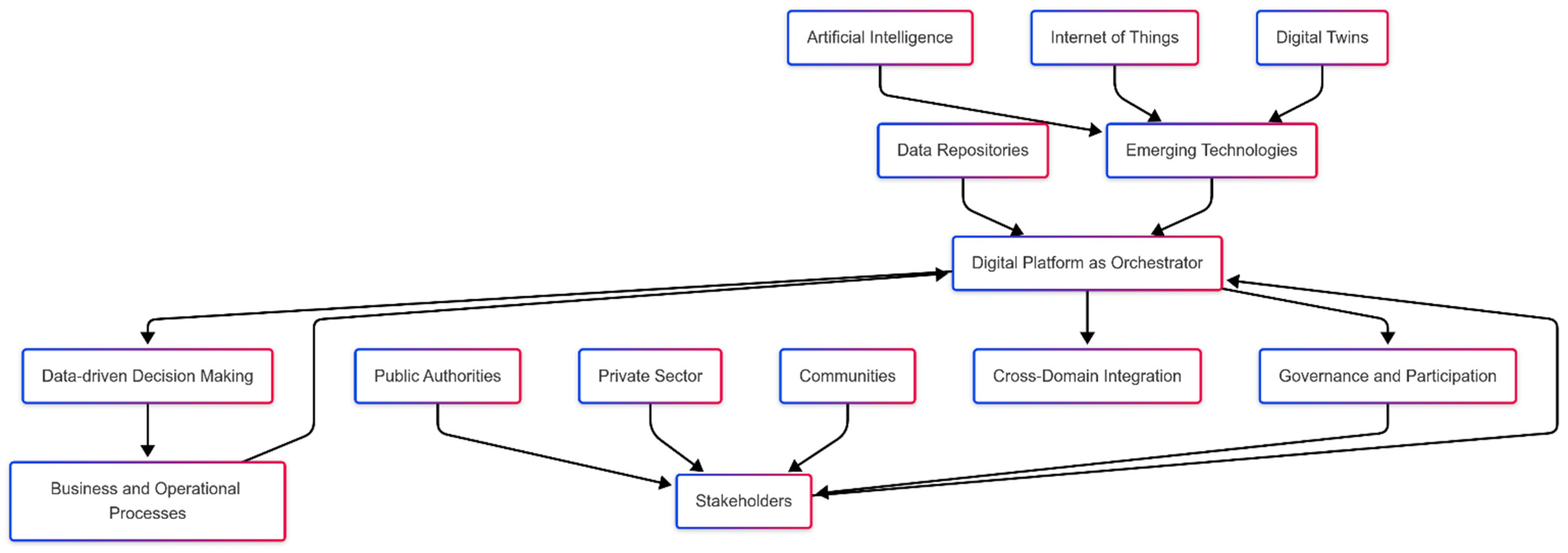
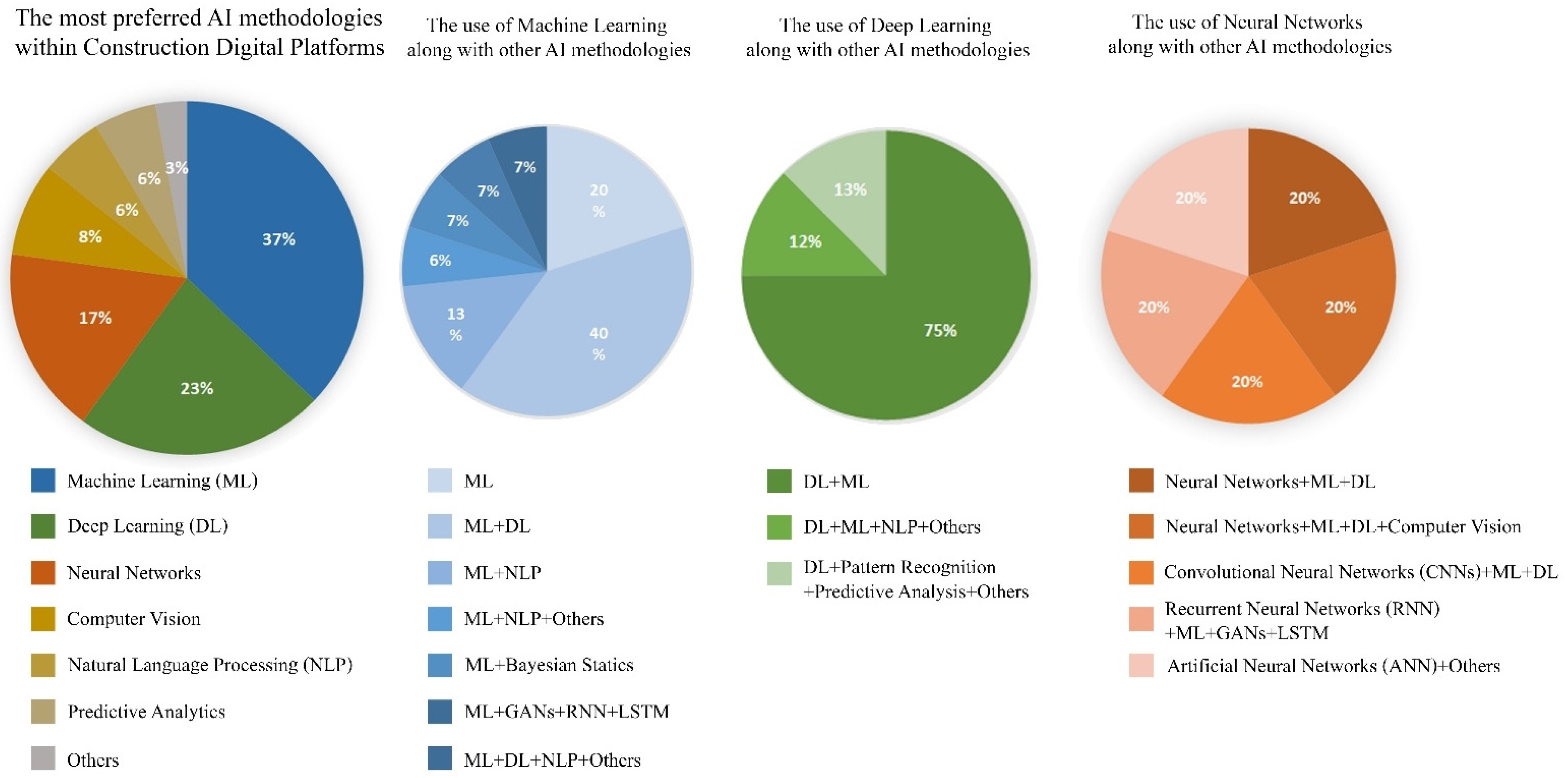
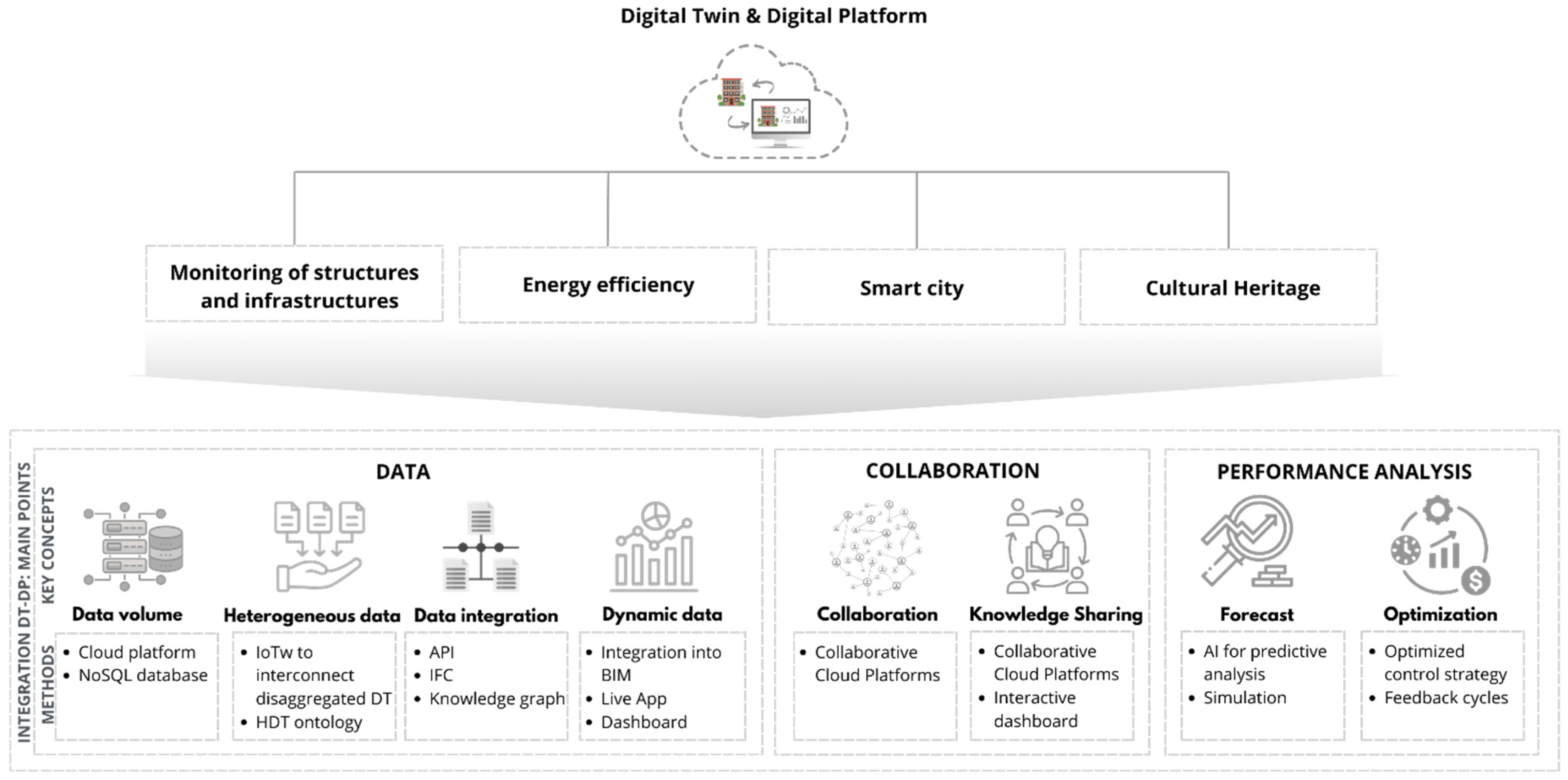
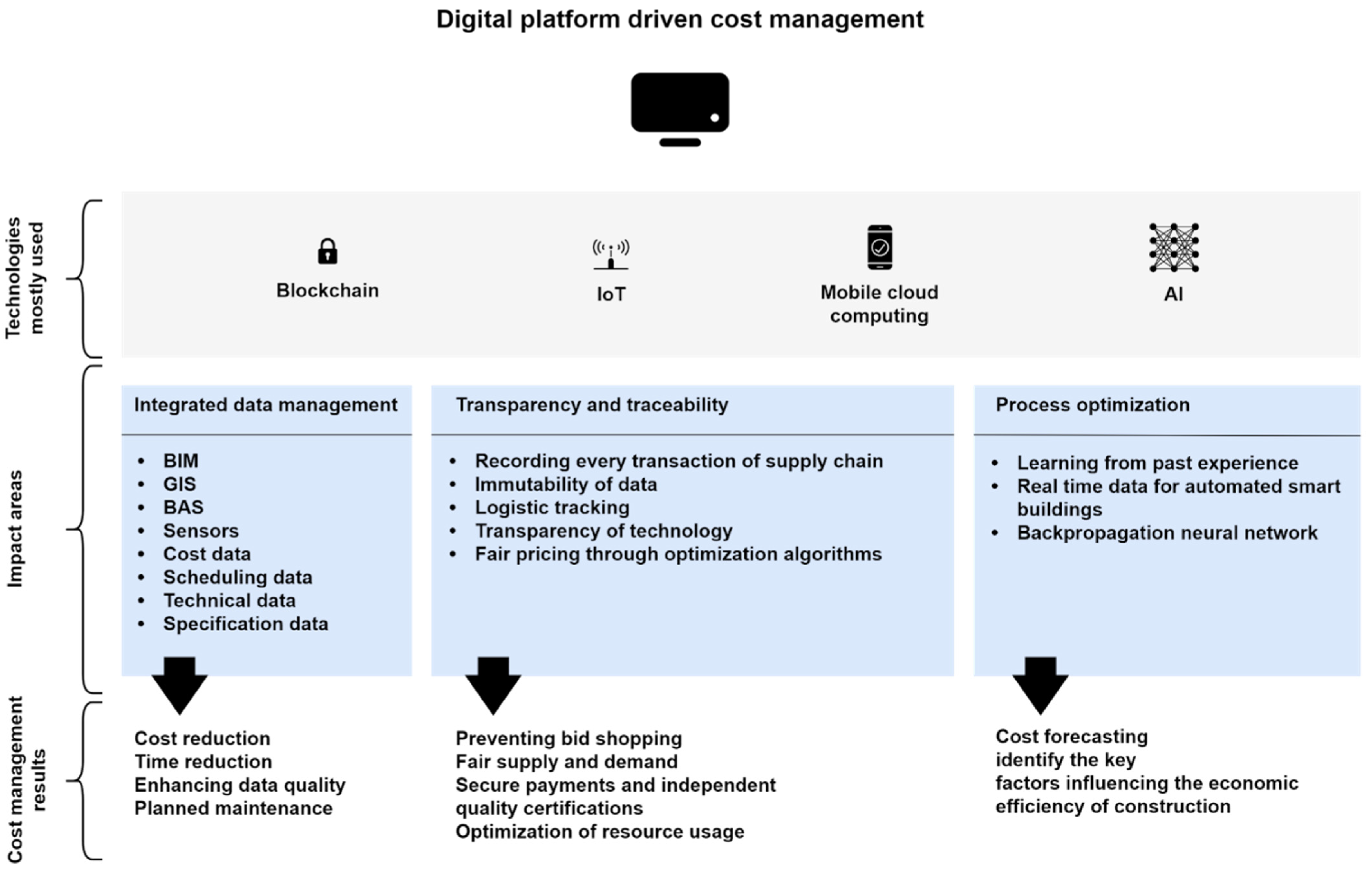
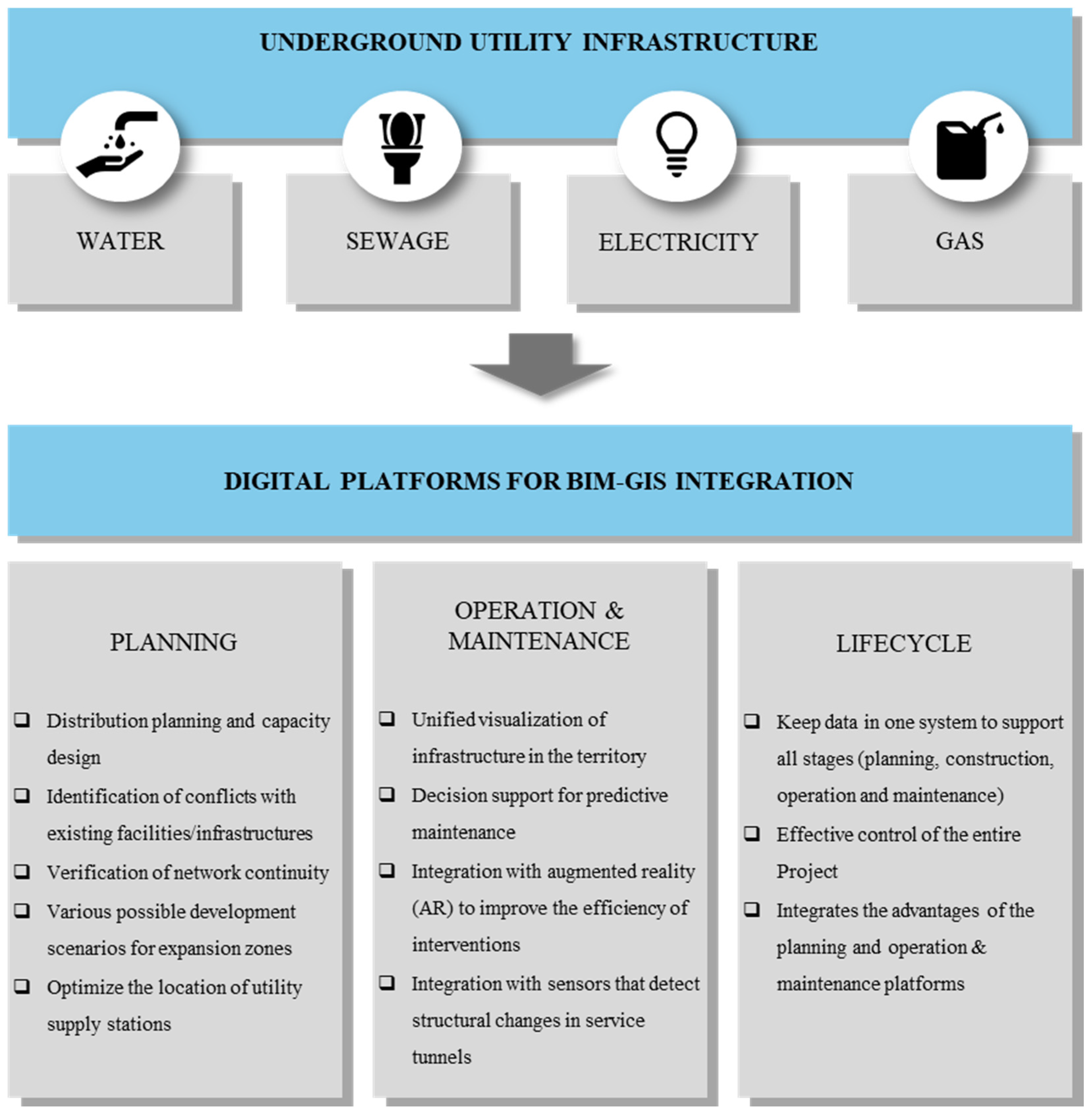
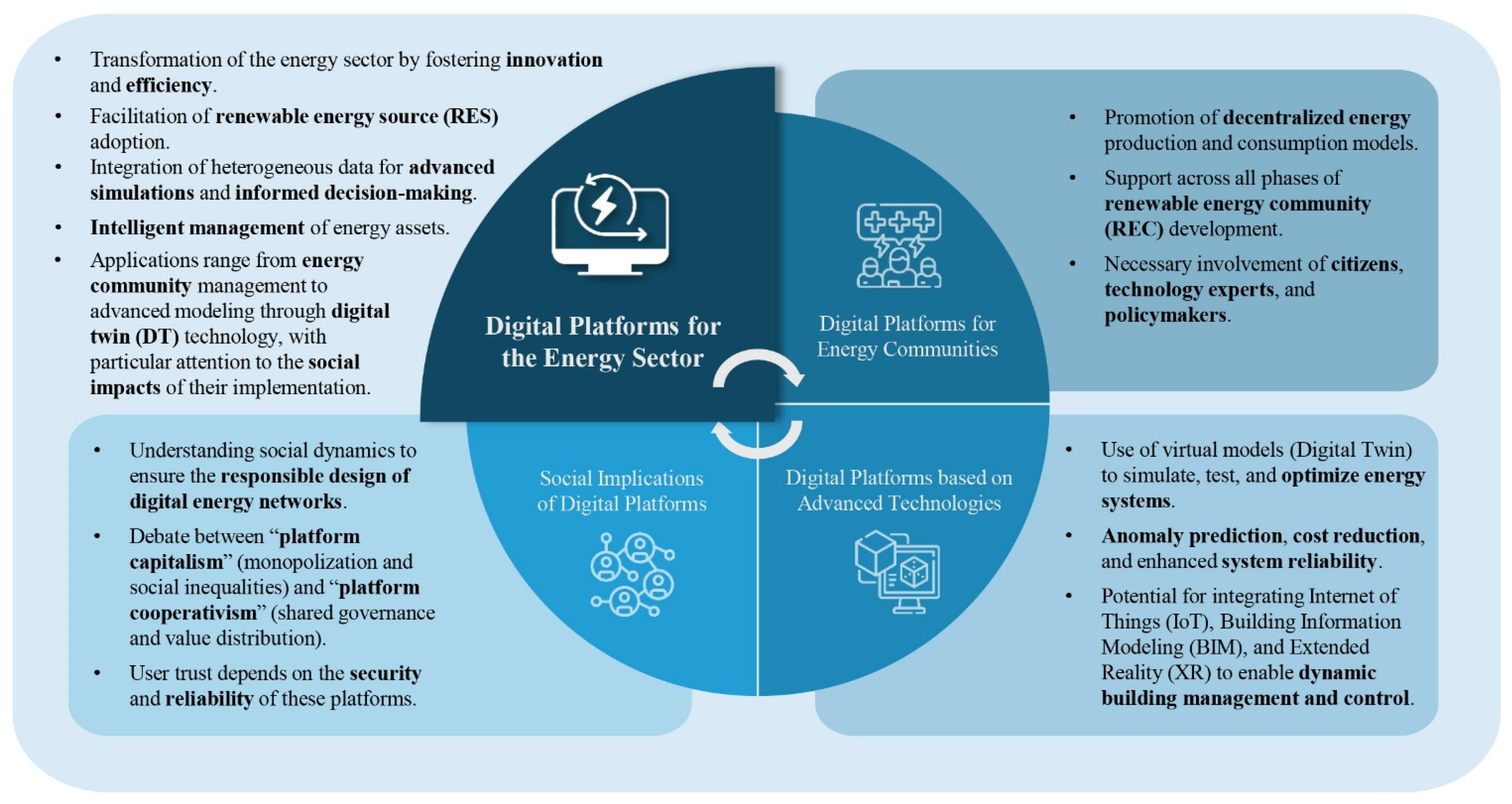
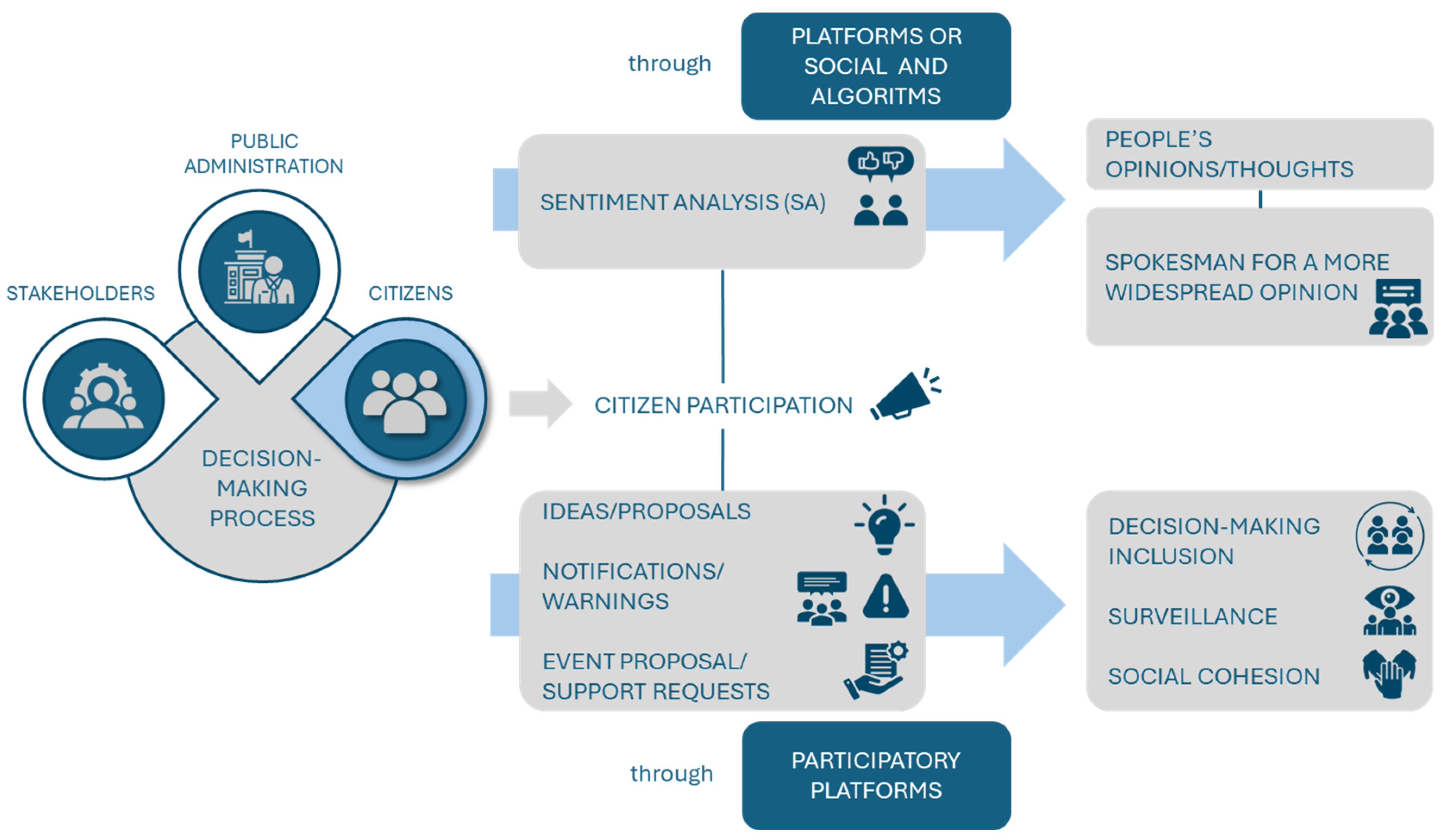
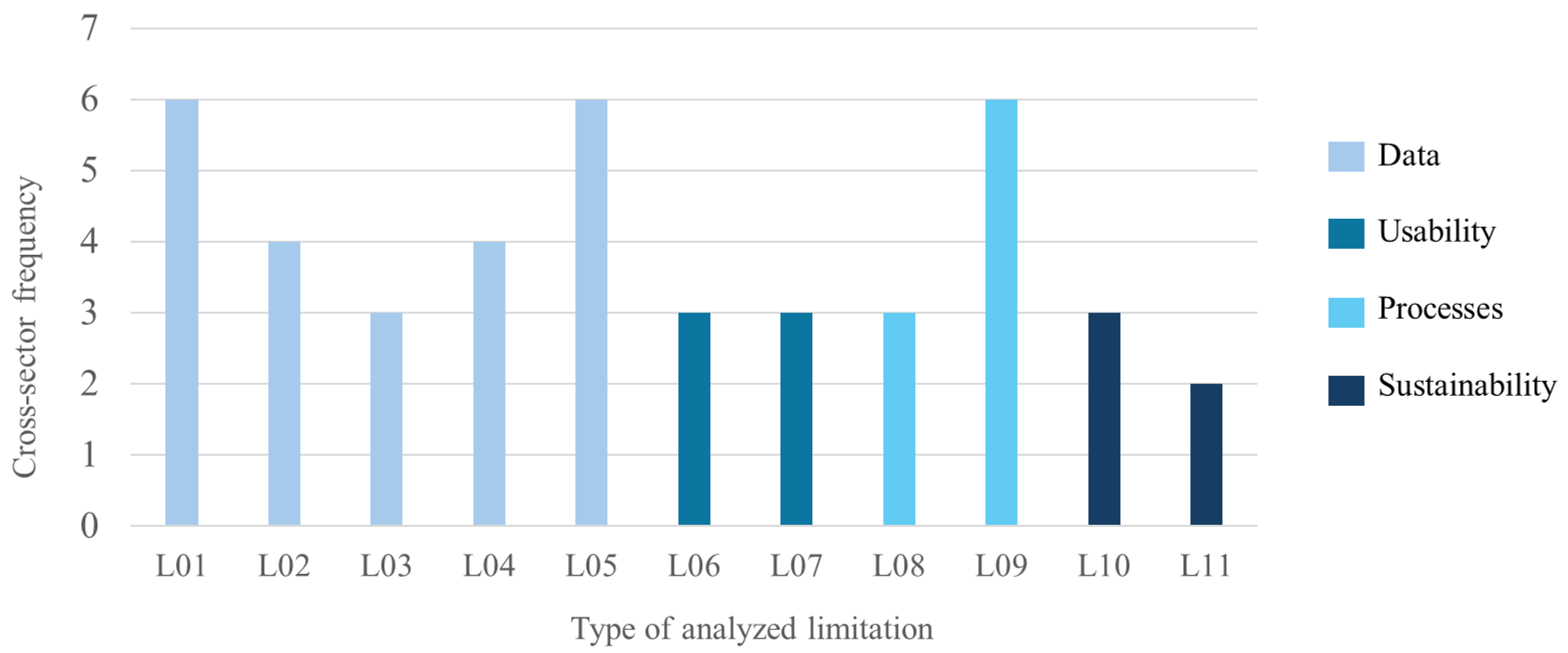
| Dimension | Examples |
|---|---|
| Domain of application | Construction, Infrastructure, Energy, Urban Planning, Public Administration |
| Functional purpose | Monitoring, Decision Support, Cost Estimation, Participatory Planning, Maintenance |
| Technological integration | AI, Digital Twin, BIM, GIS, IoT, Blockchain, AR/VR |
| Lifecycle phase or scale | Design, Construction, Operation, End-of-Life; Building, Urban, Regional Scales |
| Platform Domain | Initial Results | Abstract Screen | Full-Text Review | Final Inclusion |
|---|---|---|---|---|
| AI | 794 | 23 | 21 | 21 |
| Digital Twins | 401 | 36 | 21 | 21 |
| Lifecycle Cost Management | 61 | 28 | 17 | 17 |
| BIM-GIS for UUIs | 454 | 34 | 21 (+1 added) | 22 |
| Energy Sector | 240 | 33 | 28 (+2 added) | 30 |
| Public Administration | 111 | 19 | 13 (+1 added) | 14 |
| Total | 125 |
| Domain | ID | Primary Functions of Platforms | Typical Enabling Technologies | Main Limitations | Emerging Trends |
|---|---|---|---|---|---|
| Artificial Intelligence | AI | Predictive analytics, automation, risk mitigation, design optimization | ML, DL, Computer Vision | Lack of interoperability, high computational cost, legal and ethical concerns | AI-assisted planning, generative design, platform personalization |
| Digital Twins | DT | Real-time monitoring, simulation, infrastructure and urban system management | IoT, BIM, AI, 3D Modeling, Cloud Services, Microservices | Semantic interoperability, real-time data integration, system complexity | Urban Digital Twins, predictive maintenance, citizen engagement |
| Lifecycle Cost Management | LCM | Cost forecasting, transparency, lifecycle traceability, maintenance scheduling | BIM, IoT, Blockchain, Real-Time Dashboards | Fragmented data sources, lack of domain integration, low adoption | Blockchain-enabled traceability, integration with scheduling tools |
| BIM-GIS for UUIs | BGU | 3D visualization, utility planning, tunnel and pipeline maintenance, on-site data access | BIM, GIS, AR, LiDAR, Decision Support Systems | Lack of platforms for construction phase, proprietary tools, limited standardization | Integration with smart city platforms, use of AR for O&M |
| Energy Sector | ES | Energy monitoring, grid optimization, energy community governance, on-site data access | Digital Twins, AI, IoT, BIM, XR | Data privacy, governance model conflicts, user digital readiness | Platform cooperativism, predictive energy balancing, DT-driven building management |
| Public Administration | PA | Participatory planning, e-government services, open data access | Web Platforms, Sentiment Analysis, Open Data Systems | Institutional inertia, digital divide, low platform interoperability | AI-supported participatory tools, standardization of open data protocols |
| Macro Categories | Recurrent Limitations | Code n. | DT | PA | LCM | AI | ES | BGU |
|---|---|---|---|---|---|---|---|---|
| Data | Lack of interoperability with legacy data | L01 | Legacy data often fragmented across formats, including outdated digital files and, in some contexts, paper-based archives; incompatible file types and lack of standardization | Legacy data often fragmented across formats, including outdated digital files and, in some contexts, paper-based archives; incompatible file types and lack of standardization | Legacy data often fragmented across formats, including outdated digital files and, in some contexts, paper-based archives; incompatible file types and lack of standardization | Legacy data often fragmented across formats, including outdated digital files and, in some contexts, paper-based archives; incompatible file types and lack of standardization | Legacy data are usually paper-based or stored in proprietary file formats | Legacy data often fragmented across formats, including outdated digital files and, in some contexts, paper-based archives; incompatible file types and lack of standardization |
| data inconsistency and ambiguity | L02 | Unchecked data duplication across multiple databases | Unchecked data duplication across multiple databases | Unchecked data duplication across multiple databases | - | - | Unchecked data duplication across multiple databases | |
| lack of accessible and standardized data formats | L03 | Unstructured data | Unstructured data | - | - | Unstructured data | - | |
| large-scale data integration | L04 | Lack of data integration methods across different scales and domains | - | Lack of data integration methods across different scales and domains | Lack of data integration methods across different scales and domains (only for purely data-driven models) | - | Lack of data integration methods across different scales and domains (e.g., large-scale sensoring and models) | |
| Privacy and data security issues | L05 | Personal data vulnerability, sensitive information theft, potential damage to IT systems | Personal data vulnerability, sensitive information theft, potential damage to IT systems | Personal data vulnerability, sensitive information theft, potential damage to IT systems | Personal data vulnerability, sensitive information theft, potential damage to IT systems | Personal data vulnerability, sensitive information theft, potential damage to IT systems | Personal data vulnerability, sensitive information theft, potential damage to IT systems | |
| Usability | Expert skills required (limiting usability on large scales) | L06 | Innovative technologies in traditional analog processes | Shortage of trained personnel ready to use digital platforms | - | Shortage of AI-skilled professionals | - | - |
| Lack of user involvement with the platforms | L07 | Lack of interactive and user-friendly interfaces | Lack of interactive and user-friendly interfaces | - | - | - | Lack of interactive and user-friendly interfaces | |
| Processes | Risk of parallelized human-machine decision-making | L08 | Implicit AI models for decision-making activities | PA personnel cannot understand implicit algorithmic decisions (for implicit AI models only) | - | Data-driven only models are not explicit | - | - |
| Difficulties in addressing uncertainty in complex scenarios | L09 | Partial and variable input data | Partial and variable input data | Partial and variable input data | Partial and variable input data | Partial and variable input data | Partial and variable input data | |
| Sustainability | Implementation costs | L10 | Cross-domain feature implies more efforts in terms of required investments | Processes based on conservative business models. | Cross-domain feature implies more efforts in terms of required investments | - | - | - |
| Social implications | L11 | - | - | - | Public concerns about biased machine decision-making | Public concerns about unequal access to energy resources | - |
Disclaimer/Publisher’s Note: The statements, opinions and data contained in all publications are solely those of the individual author(s) and contributor(s) and not of MDPI and/or the editor(s). MDPI and/or the editor(s) disclaim responsibility for any injury to people or property resulting from any ideas, methods, instructions or products referred to in the content. |
© 2025 by the authors. Licensee MDPI, Basel, Switzerland. This article is an open access article distributed under the terms and conditions of the Creative Commons Attribution (CC BY) license (https://creativecommons.org/licenses/by/4.0/).
Share and Cite
Berlato, M.; Binni, L.; Durmus, D.; Gatto, C.; Giusti, L.; Massari, A.; Toldo, B.M.; Cascone, S.; Mirarchi, C. Digital Platforms for the Built Environment: A Systematic Review Across Sectors and Scales. Buildings 2025, 15, 2432. https://doi.org/10.3390/buildings15142432
Berlato M, Binni L, Durmus D, Gatto C, Giusti L, Massari A, Toldo BM, Cascone S, Mirarchi C. Digital Platforms for the Built Environment: A Systematic Review Across Sectors and Scales. Buildings. 2025; 15(14):2432. https://doi.org/10.3390/buildings15142432
Chicago/Turabian StyleBerlato, Michele, Leonardo Binni, Dilan Durmus, Chiara Gatto, Letizia Giusti, Alessia Massari, Beatrice Maria Toldo, Stefano Cascone, and Claudio Mirarchi. 2025. "Digital Platforms for the Built Environment: A Systematic Review Across Sectors and Scales" Buildings 15, no. 14: 2432. https://doi.org/10.3390/buildings15142432
APA StyleBerlato, M., Binni, L., Durmus, D., Gatto, C., Giusti, L., Massari, A., Toldo, B. M., Cascone, S., & Mirarchi, C. (2025). Digital Platforms for the Built Environment: A Systematic Review Across Sectors and Scales. Buildings, 15(14), 2432. https://doi.org/10.3390/buildings15142432








